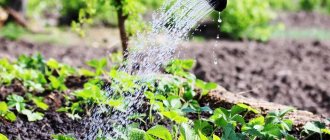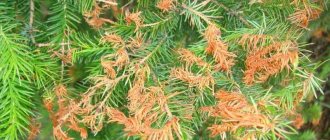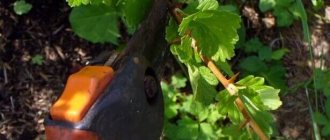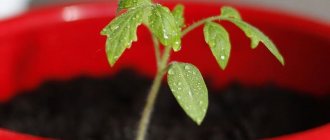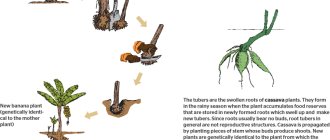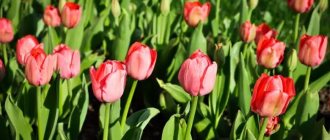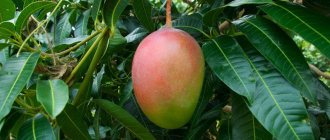Good time, dear readers of our blog. I have always been attracted to the exotic garden crops that grow on the plots of some gardeners. This is exactly what I include tomentose cherries, which have successfully taken root in the gardens of the middle zone and delight their owners with excellent harvests.
It is now difficult to call it exotic, but for many this culture remains a wonderful stranger. How and when to plant felt cherries, what soils are suitable for them, agricultural techniques, the value of the berries - there are many questions, and we will try to answer them.
Felt cherry: photo and description
Initially, this crop was used as a decorative one, all thanks to its luxurious greenery and beautiful flowers. The homeland of the felt cherry is China, however, it is found there in the wild, and in our gardens varieties are cultivated that were bred as a result of painstaking breeding work.
Externally, it is a small shrub with a very lush crown, the leaves are small and corrugated. Cherry blossoms look great when the bush is covered with pink and white flowers. Flowering usually begins in early May.
Berries ripen from mid-July. The fruits are small, very tightly adjacent to each other on the branch, with juicy sweet pulp and a small stone. The color of the berries depends on the variety and varies from bright red or scarlet to almost black, chocolate. Since this cherry is a low-growing shrub, it is not difficult to collect the fruits, and even very overripe cherries do not fall off the branches. The yield is good; from one felt cherry bush, with proper care, you can harvest up to 12-15 kg of berries.
The fruits contain a lot of vitamin C and iron; eating them helps improve digestion and strengthen blood vessels.
Rules of care
Felt cherry is quite unpretentious when grown in open ground. For its normal growth and development, minimal care is required:
- timely watering;
- periodic feeding;
- spring pruning;
- loosening the soil.
Let's take a closer look at each stage.
Watering
Felt cherry does not like waterlogging. Excess moisture adversely affects the growth and development of the tree. Even in summer, during periods of prolonged drought, it is watered moderately. The harvest takes place in July-August. Stopping watering will help prevent fruit cracking during this period.
Top dressing
Periodic application of fertilizers is a guarantee of a healthy tree and large yields of tasty berries. The first application of fertilizers with nitrogen-containing elements is carried out in early spring, before flowering begins. The bush is fed a second time after harvesting.
See also
Causes and treatment of apricot diseases, what to do and how to get rid of pests
Read
Loosening and care of the tree trunk circle
The tree trunk circle requires periodic loosening. It is especially relevant after a period of prolonged rains and abundant watering. The soil is loosened carefully, trying not to damage the root system.
Felt cherry pruning
For normal growth and development, it is necessary to pay attention to the shape of the bush, which even a novice gardener can easily cope with. When planted in open ground, the young seedling is cut at a height of 40 cm. The next year, all side branches are removed to a third of the height.
The scheme for annual rejuvenating pruning in the spring is standard. It involves removing old, frozen and damaged branches. This pruning promotes active growth of the bush and activates fruiting. The crown should not be allowed to thicken. A thick crown prevents the free penetration of sunlight, causes stagnation of excess moisture and often becomes the main cause of various fungal diseases.
During formative pruning, the ten strongest and healthiest shoots of the felt cherry are left, and excess branches are removed.
In autumn, pruning is carried out in regions with a mild climate and warm winters. In the northern regions, late pruning can provoke various diseases and often causes the death of the bush.
Preparing the tree for winter
Proper preparation of felt cherries for cold winter is the key to high yields in the following years. Experienced gardeners take special care in preparing the garden for harsh winters. To do this, after the leaves have fallen, perform the following work:
- in regions with a temperate climate, sanitary pruning is performed;
- carry out root feeding;
- treat the bushes from pests;
- the lower part of the trunk is whitened.
In cold regions, a young bush requires careful insulation. Mulching around the tree trunk helps prevent freezing of the root system at low temperatures. For this you can use the following materials:
- compost;
- dry grass or straw;
- foliage;
- shavings;
- peat.
Covering materials are excellent protection against winter frosts. They allow fresh air to pass to the root neck, but are a reliable barrier to cold.
Dealing with landings
Deadlines
Felt cherry seedlings are purchased from nurseries, and the best time for planting is spring. Optimal for the middle zone is April, for the north-west - maybe a little later, for example, the very beginning of May.
What to do if you bought seedlings in the fall? If this happened in September and the temperature conditions allow it and no cold snap is expected, then you can plant cherries. If the calendar says October, then it’s better not to risk it and bury the young seedlings until spring.
IMPORTANT! For seedlings that are buried for the winter, you need to carefully remove all the leaves. It is also necessary to take care of shelter in case of a frosty winter and to protect them from rodents.
Selecting a location
Cherry loves sunny places, so try to choose a comfortable, good corner on your site for it. You cannot plant this fruit crop in a lowland, and you will not get a harvest, and the tree may die.
The soil
Everything is simple here: heavy soils and peat bogs are not suitable for cherries. Grows well on sandy loam soils, as well as on light loam. It is allowed to add a small dose of organic matter, as well as phosphorus-potassium fertilizers.
Planting seedlings
Planting is carried out in prepared holes, the depth of which is approximately one and a half meters.
After planting, it is advisable to lightly compact the soil and mulch it with peat. Frequent watering is not necessary; the condition of the soil is monitored and, if necessary, the seedlings are watered. Features: before planting, it is recommended to trim the roots of the seedling a little (by about 20 cm), and then dip the roots in a specially prepared clay mash.
IMPORTANT! The root neck of the cherry seedling should be at a level of 4-5 cm from the surface of the ground.
For planting, use the following mixture as fertilizer:
- 800-900 g lime
- 30 g potassium
- 60 g phosphorus
The composition is given per 1 square meter
Be sure to control the planting pattern, planting cherries at a distance of at least 2 meters from each other.
IMPORTANT! Experts advise not to plant cherries next to conifers, as this does not have a very favorable effect on its growth and productivity.
Cherry replanting in April. When can you replant cherries?
Cherries are replanted like other fruit trees. The fruit tree (plum, apple, pear) should be at rest. This condition occurs in early spring or autumn, when the leaves have fallen. Replanting in summer is not allowed. Some trees are replanted in August.
The timing of replanting depends on the type of tree. Some varieties cannot be replanted in the fall; they will not take root and will die.
When choosing a date, they are guided by air temperature and climatic conditions.
When to replant depends on the region:
- In Siberia, the Urals, and the Moscow region, they are transplanted only in the spring. For this purpose, frost-resistant varieties are used.
- In the Far East, rely on weather forecasts. Otherwise you will lose the seedlings.
Transplantation in spring
During this period, the tree is weak and the likelihood of diseases is much greater. Various parasites can interfere with its development.
A transplanted cherry tree in the spring has time to gain strength over the summer. This allows you to achieve good results. If a tree is replanted in the spring, it will develop and bear fruit over the summer. All energy goes into the fruits and growth of the cherry. Thus, there is little strength left to strengthen the roots. Which has an adverse effect on rooting and further development.
In a region with a cold climate, the only time to replant is the spring months. The optimal temperature for transplantation is not lower than 10 degrees Celsius.
Transplantation in autumn
In autumn, plants need to be planted before frost. The best time for replanting is mid-September - mid-October. The time is chosen so that the cherries have the opportunity to gain strength before frost appears.
A plant with unfallen leaves cannot be replanted. Otherwise it will die. If you replant a tree at this time, you can get a harvest in the summer.
The pit for autumn transplantation is prepared in advance. In the spring, they dig a hole and apply organic fertilizers. And then a tree is planted in this hole.
How to properly care for felt cherries
So, the main agricultural techniques include:
- feeding;
- loosening;
- watering;
- pruning
It is recommended to fertilize two years after the seedlings are planted. Complex fertilizers are used and applied in spring and autumn. At the same time, it is important to take into account the benefits and harms of nitrogen, because in the spring it must be in fertilizers for plant growth, but in autumn fertilizing nitrogen is excluded.
Loosening is carried out as necessary; this is done very carefully, since the roots of the felt cherry are located close to the surface of the earth.
Watering is moderate; the soil should not be over-moistened.
Reviews from gardeners
Helga
Felt cherry is self-sterile. For harvests, you either need “neighboring” explosives or buy different varieties.
Source: www.forumhouse.ru
Olga Alekseevna
To produce felt trees, there must be several genetically different trees on the site, i.e. seedlings are good as pollinators; they are always different, but cuttings from the same thing are not.
Source: forum.tvoysad.ru
How and when to prune felted cherry trees
The issue of pruning such cherries is very important, since this procedure promotes the growth of the bush and good fruiting.
In the first year, the cherry tree, which has reached a height of about half a meter, is carefully trimmed. In the second year, the side branches of the crown are cut off (by about one third) to prevent it from thickening.
It is best to do pruning in the spring, being sure to remove all diseased and dry branches. Visually select approximately 10-12 healthy, strong shoots, and trim the rest as well. A thickened crown of felt cherries means diseases, fungi, low yields and even the death of the crop. If there are a lot of branches, pruning is allowed twice a year. But as practice shows, one procedure is quite enough.
Correct, careful sanitary pruning is the guarantee that your cherry tree will not get sick, but will delight you with flowering and good harvests.
Growing conditions
Felt cherry is very undemanding to growing conditions. Thanks to these qualities, it has found widespread distribution in suburban and dacha plots in every corner of Russia. For its timely development and good fruiting, it is necessary to adhere to the minimum agrotechnical requirements:
- choose a suitable landing site;
- ensure timely watering and fertilization;
- organize a mulch layer in the tree trunk circle;
- perform timely pruning;
- protect from winter cold.
These simple steps will allow you to grow fragrant felt cherries in your own garden and enjoy the incredible taste of its berries.
Optimal location and lighting
The most suitable place for planting is a sunny, open area of the dacha. The bush does not tolerate shading well, so when planning a garden it is located as far as possible from tall trees. The plant does not take root well in lowlands and holes where excess moisture accumulates. In such conditions, the root system develops poorly and rots over time.
Soil composition
Felt cherry requires fertile soil. The close location of groundwater will prevent the timely development of young seedlings. Loams and sandy soils with a neutral reaction are ideal for growing this shrub.
Favorable and Undesirable Neighbors
For active fruiting, felt cherries require favorable neighbors. Cross-pollination occurs well between different varieties with the same flowering period.
The shrub gets along well with common cherries and sweet cherries. However, such planting requires enhanced preventive measures against moniliosis. Feels good with hawthorn, grapes and rowan. Planting the bush away from tall trees will help avoid darkening and growth inhibition.
Felt cherry diseases and their treatment
A huge advantage of felt cherry is that it is practically not susceptible to coccomycosis. Experienced gardeners know how dangerous this disease is for ordinary cherries, but for this felt beauty, coccomycosis is not terrible.
But there is another danger - this is monoliosis or, as it is also called, monilial burn. The reason is a marsupial fungus that penetrates flowers and affects young shoots. When moniliosis develops in the spring, the cherry tree either loses its color or dries out after flowering, the tree stands as if damaged by fire.
In the summer, moniliosis affects the branches and trunk, the bark begins to crack, and gum appears. If no action is taken, the cherry tree will quickly die. Cherries in orchards in the Urals, Siberia, and the northwestern region especially often suffer from this disease.
How to deal with moniliosis
For prevention:
- It is necessary to choose varieties for planting that are less susceptible to this disease.
- Plant only in elevated sunny places.
- Regular pruning of the felt cherry crown is mandatory.
- It is recommended to carry out lime whitewashing of the skeletal branches of the cherry tree (at the base) and the trunk.
- Carry out special spraying to destroy insect pests that are carriers of the marsupial fungus.
If the tree is already sick, you see that some branch has dried up, then you need to immediately cut it out. During the flowering period, spraying with special preparations is allowed:
- zineb;
- inkstone;
- topsin-M.
Fruits from such trees should be used for food no earlier than 25-30 days after chemical treatment.
A good effect is obtained by treating the trunk and branches of the crown with preparations containing copper. This treatment should be done after harvesting, in order to prevent and prevent the appearance of the disease.
Diseases, pests
No matter how resistant the felt cherry is to disease, if care is not taken care of, it can develop a fungal infection. You also cannot be 100% insured against harmful insects.
Moniliosis
Most often, felt cherry is affected by the monilia fungus. A monilial burn can be recognized by a number of signs:
- dried, as if burned or frozen leaves and branches;
- flowers and leaves turn brown and then fade;
- a grayish coating appears on the berries, they become brown, and the taste of the pulp takes on a hint of alcohol;
- the berries become mummified and in this form can either fall or remain hanging on the branches without falling off;
- small whitish compactions form on the petioles;
- Gum production begins.
The causative agent of the disease is the fungus Monilia cinerea. Spores are carried by wind and insect pests and penetrate the plant through damaged bark. They overwinter in fallen leaves and fruits. Active development of the fungus occurs at air temperatures from +15 ° C to +20 ° C and humidity close to one hundred percent.
To prevent disease, diseased parts of the cherry tree are removed and destroyed. And also fallen leaves. It is imperative to pull out the weeds under the bushes and avoid excessive moisture in the berry garden. Before wintering, the trunks are whitened with lime, the cherries are sprayed with fungicides, and the soil in the circle around the trunk is dug up. This measure will also help against pests.
Moniliosis is one of the most dangerous diseases of felt cherry
Clusterosporiasis
Much less often than moniliosis, felt cherries can develop clasterosporia blight, to which most varieties have average resistance. In another way, this disease is also called hole spotting; in addition to cherries, it can affect cherries, plums, peach, and apricot.
The cause is the fungus Clasterosporium carpohilum. You can recognize the presence of infection in felt cherries by the following signs:
- the appearance on the leaves of round light brown spots with a crimson edging;
- over time, holes form in place of the spots;
- the leaves dry out and fly off;
- reddish spots appear on the shoots and buds;
- gum secretion;
- falling of affected shoots;
- purple sores appear on the berries;
- the fruits may dry out on one side.
Severe damage to branches and shoots can lead to the death of the cherry. As with any other fungal infection, with clasterosporiasis it is necessary to get rid of the infected parts of the plant, they need to be burned. The crown, trunk, and also the trunk circle are treated with fungicidal preparations. To prevent the disease, do not allow waterlogging in the berry garden, prevent the growth of weeds, remove carrion in a timely manner, and fight insect pests.
Among the harmful insects found on the felt cherry are the plum moth, aphids, and leaf rollers.
Plum moth
The plum moth causes great harm by eating the pulp of the fruits of stone fruits. The pest is widespread everywhere. An adult is a brown butterfly with a wingspan of 1.2-1.5 cm, the lower wings are noticeably lighter than the upper ones, and there is a fringe along the edges.
Plum moth caterpillar
The flight of butterflies occurs in the middle of summer. They live no more than two weeks, during which time they manage to lay eggs on the berries or the underside of the leaf plate. The hatched caterpillars are first off-white and then reddish in color, feed on the pulp of the fruit, and can also damage the seed in unformed berries. The cherry stops developing and falls off. Caterpillars overwinter, wrapped in a cocoon of cobwebs in the bark or in the upper layers of soil, on plant debris. In the spring, as soon as the air warms up to + 10 ° C, the overwintered larvae pupate. The next generation of butterflies emerges in June-July.
To combat the plum moth, the following measures are taken:
- after flowering, the berry garden is treated with insecticides such as Fitoverm, Iskra Bio;
- during berry set, repeated processing is carried out;
- when the cherry blossoms fade, trapping belts made of adhesive material are placed on the trunks;
- regularly remove damaged and fallen berries;
- digging up the soil under the trees;
- remove plant debris.
You can use such an environmentally friendly method as attracting natural enemies of the codling moth - birds - to the garden.
Aphid
Another pest that can be found on felt cherries is aphids. It often starts in gardens where there are many anthills. The aphid pierces the tender young leaves with its proboscis and feeds on the intercellular sap, weakening the plant. To get rid of aphids, leaves with insect colonies are torn off and burned. The bushes are treated with infusions and decoctions of herbs according to folk recipes. A soap and water solution has also worked well. It is prepared by mixing a glass of ash with one piece of laundry soap diluted in water. If there are too many aphids, you can resort to industrial insecticides such as Iskra, Admiral, and Commander. But it is better to use them only in the most advanced cases.
Caring for felt cherries is easy, this is also one of the reasons for its popularity among summer residents.
How to propagate cherries
Felt cherry is a very productive crop; in addition, gardeners love it for its unpretentiousness and very beautiful early flowering. Therefore, the desire to increase the number of such trees in the garden is understandable. Felt cherry can be propagated in different ways:
- Seedlings (the method is discussed in detail above).
- Layering (adult plants are used for this).
- Sowing cherry pits.
Grafting is also used, and most often gardeners use cherry plum, plum or bird cherry as a rootstock.
Propagation by layering is quite easy. To do this, in the spring, healthy annual shoots are selected from the bush, bent to the ground and pinned very carefully. First you need to make small grooves and bend the shoots into them. Next, you need to cover the shoots with soil and water them regularly. Over the summer the shoots will produce roots and new shoots. At the beginning of September, the seedling can be divided into several parts, or left as is, so that there is only one.
How to grow felt cherries from seeds
The method is reliable, since out of 10 seeds, usually 6-7 give a good shoot, which completely replicates the mother tree.
For planting, you need to take seeds from large, ripe fruits that are collected from healthy trees. They need to be separated from the pulp, washed and dried (not in the sun), and then stored in a polyethylene bag.
Around the end of August, the seeds are taken out, mixed thoroughly with river sand, slightly moistened and left in a cool place. Sowing is done before the onset of cold weather (each area will have its own conditions, but in time - about 20 days).
Main stages of planting:
- Preparation of small grooves, the depth of which is approximately 2 cm;
- Planting seeds in furrows directly with sand, distance - approximately 50 cm;
- Sprinkle the seeds with peat or sawdust, lightly with soil.
In the spring, after the snow melts, cherry sprouts are carefully examined and the strongest shoots are selected. In summer, care is simple: watering, careful loosening, removing weeds.
For the winter, it is better to cover young cherries with covering material and snow so that the seedlings do not freeze. But they should be transplanted from the furrows to a permanent place only in the second year, choosing either spring or autumn for this.
If everything is done correctly, then your felt cherry, grown from a stone, will produce the first berries in the third year.
Reproduction methods
In summer cottages, felt cherries are propagated in several ways:
- seeds;
- cuttings;
- layering.
Let's take a closer look at each type.
Seeds
The easiest way to grow felt cherries in your own summer cottage is to plant seeds in open ground. To do this, juicy berries are taken from the most productive bushes and the seeds are separated. Sowing is done in mid-autumn or spring. When planting in spring, the seeds require preliminary stratification at a temperature of 3-5 °C.
Breeding felt cherries with homemade seeds allows you to preserve all the characteristics of the mother plant and obtain rich harvests with excellent taste of the berries.
Cuttings
Felt cherry can also be propagated by cuttings. For this, the middle part of annual green twigs is used. The cuttings are placed in a nutrient solution that stimulates the formation of the root system for a day, and then planted in open ground. Within a month after planting, they take root and grow.
See also
How to grow cherries on your own plot, planting and care
Read
By layering
Very rarely, felt cherry is propagated by horizontal layering. To do this, the lower healthy branch is carefully bent and sprinkled with earth. When strong roots appear, the branch is separated from the mother bush, and the plant is transplanted to a permanent place.
Let's talk about varieties
Bearing in mind that felt cherries will not bear fruit if you have only one variety planted, you need to know what varieties of this crop exist.
Early felt cherry
Natalie
The group of early ripening varieties includes the Natalie variety, which is currently one of the most widespread. It is distinguished by very juicy large berries that have a dark red color. The fruits ripen together, approximately in the second half of July. Productivity – up to 10 kg per bush. The best pollinators: varieties Ogonyok and Damanka.
Fairy tale
This variety is popular both in the Moscow region and in Siberia because of its magnificent flowers and delicious fruits. In addition, Skazka is one of the shortest varieties of felt cherry, its height reaches an average of one meter.
The berries are large, sweet, and have dense pulp. Skazka is distinguished by a high degree of resistance to fungal diseases.
Felt cherry average ripening time
Anniversary
This is a new variety that was bred by breeders in 1997. It is distinguished by a not too thick crown and an interesting slightly concave shape of the leaves.
The berries have an oblique shape, burgundy, the pulp is sweet, with a refreshing taste. From one bush you can collect up to 8-9 kg of fruit.
Eastern dark-skinned woman
The variety differs from others in that the flowers are located on long stalks, and the branches have a reddish tint. The berries are medium-sized, have a small “beak”, and are dark burgundy at the ripening stage. Productivity is average.
Late felt cherry
Firework
This variety of felt cherry is characterized by massive fruiting and good yield (up to 10 kg of fruit from one bush).
Feature of Salyut: the first fruits begin to appear only 4-5 years after the seedlings are planted in a permanent place, so you need to take this fact into account. The berries are large, oval, the pulp is slightly sour.
Autumn Virovskaya
A tall, productive variety with good winter hardiness. The fruits are large, highly palatable and delicious.
Ocean
It is a tall variety and can reach a height of up to two meters.
The berries are not particularly large, very beautiful, the flesh is dense and juicy. Productivity is approximately 8 kg of fruits per bush. Feature of the variety: the fruits lack a pronounced cherry aroma. When planting, varieties of the same flowering period should be planted nearby so that pollination takes place effectively and fruits set.
We think that our article will help you choose the best varieties of felt cherries for the garden and correctly plant this wonderful fruit crop.
Severova Natalya
How to plant on the site
Before planting felt cherries at your summer cottage, you need to prepare the planting site and the seedling itself. A number of simple measures guarantee easy survival and transformation of a weak seedling into a healthy, luxurious bush.
Timing of planting work
In autumn, as a rule, felt cherry trees are not planted. When planted late, the superficial root system does not have time to adapt to environmental conditions. The bush will die from the first frost.
Felt cherries are planted in early spring before the buds open. During the warm period, the plant has time to get stronger and will meet the winter with a supply of nutrients and a developed root system.
Preparing the seedling and planting hole
To ripen the sweet berry, the shrub is planted in an open sunny area. Depending on the terrain and type of soil, the soil requires preliminary preparation. It is mixed with sand, lime and fertilizers. To improve the soil structure, you can add a small amount of vermiculite. On poor soils, it is advisable to use ready-made specialized soils.
Felt cherry does not require deep pit equipment. In the fall, a planting hole about half a meter deep is dug for the seedling and the soil is well fertilized. In the spring, drainage is placed at the bottom of the planting hole, partially filled with soil and a small mound is created.
The seedling is placed in a mixture of clay, ash, and growth stimulant and carefully placed on a mound, evenly distributing the root system. The planting hole is covered with earth and lightly compacted. The root collar is not buried.
To prevent the formation of weeds, retain moisture and protect weak seedlings from late frosts, the soil under the bush is mulched with humus, dry leaves or sawdust.
Disembarkation algorithm
The distance between seedlings should be at least two meters. When growing several shrubs, a sparse planting pattern is used: 3 x 1.5 meters.

